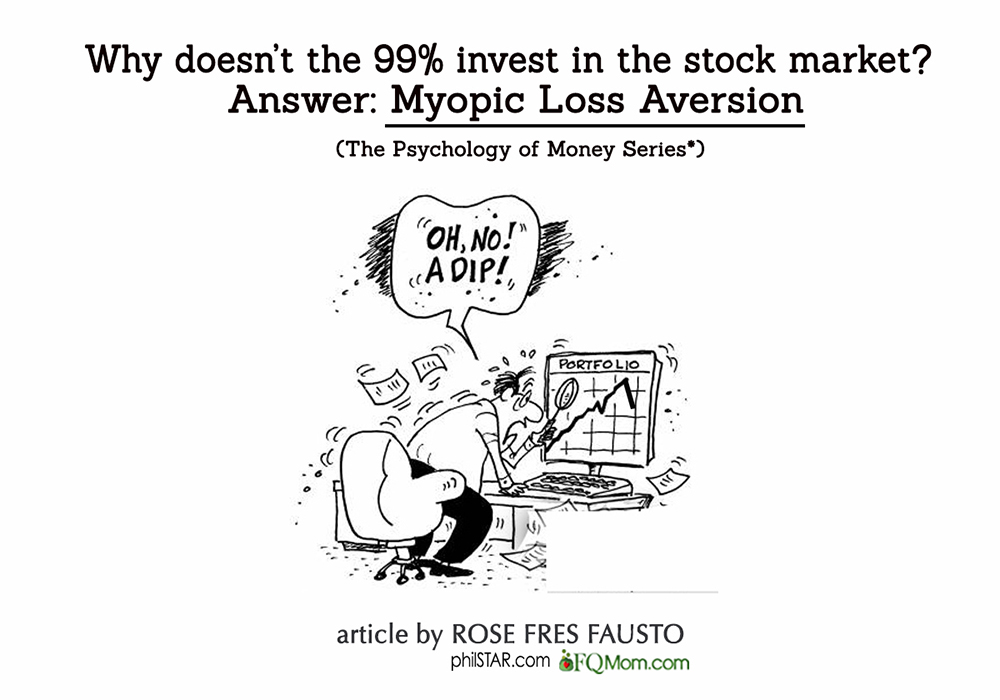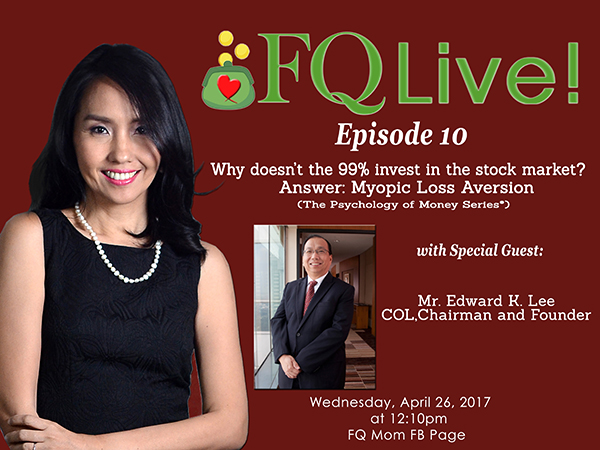Why doesn’t the 99% invest in the stock market? Answer: Myopic loss aversion


(The psychology of money series)
Wharton professor Jeremy Siegel wrote a landmark book entitled “Stocks For The Long-Run” wherein he discussed his findings on the returns of the different asset classes over the span of almost two centuries. The first edition came out in 1994 and the fifth one on its 20th anniversary in 2014. This book shows hard evidence that stocks provide the highest returns among all asset classes in the long run. He compares periods of 10, 15, 20, 30 years and so on.
Given these historical records and the fact that we all have to prepare for an important long-term goal (i.e. decent and financially happy retirement), how come only a miniscule less than 1 percent is investing in this asset class?
To answer this, I wish to discuss with you some points in the study done by the father of Behavioral Economics, Richard Thaler, together with Shlomo Benartzi. This study done in 1993 is entitled “Myopic Loss Aversion and the Equity Premium Puzzle.”
The terrible two combination
Moms like me would know that the “terrible two” is that interesting stage in our children’s development at age two when they struggle between their dependence on their caregivers and their need to be independent from them such that they always say “No!”
For today’s article, I will discuss terrible two as the combination of two factors that make investors say “No!” to the stock market way too much, to their detriment. To Thaler and Shlomo, this is called myopic loss aversion (MLA). Below are its components.
1. Loss aversion. Last week I discussed this principle in my article entitled “Loss aversion (The psychology of money series).” Investors are loss averse. They feel the impact of a loss twice as much as that of a gain. Consequently, they avoid the uncertainty of a loss way too much, especially if the framing of the mind is set to think about gaining (Click link to read article in full).

2. Investors evaluate their portfolios frequently. This is a case where vigilance takes its toll on your financial well-being. In general, it is good to be always on top of your investments. Unfortunately, the human wiring of being loss averse is in bad tandem with frequent evaluation of portfolios.
Let’s talk about your investment for your retirement. Assuming you are now 30 years old, setting aside money for your decent and financially happy retirement in 30 years. But you look at your portfolio way too often that you always get the jitters when the market goes down. Even if you very well know that you would still use that money in 30 years, and you know that it’s normal for the stock market to move up and down and not in a linear way, that you should in fact be buying more when the market is down, what do you end up doing? You panic and sell when the market is down. When the market is high, you get delirious with irrational exuberance that you put in more money than you should (Read The emo cycle of investing to see the different stages). Because of your emotions caused by constant evaluation, you become short-sighted or myopic!

The above terrible two called MLA is the culprit why 99 percent of our population is not investing in stocks but would regularly buy lotto tickets, or even text while driving or cross the street on a non-pedestrian lane, risking life and limb. Don’t we just have a distorted risk appetite? ![]()
Are seasoned fund managers spared from MLA?
The Fund Managers Association of the Philippines (FMAP) successfully celebrated its 20th anniversary last week. Congratulations FMAP! From P1 billion of equities managed by its original members 20 years ago, FMAP members now manage a total of P4.5 trillion in fixed income and equities. Mind you, the fixed income is still bigger than the equities.

I attended an interesting event last week conducted by the FMAP together with the CFA Society entitled “How Do Investors Win?” It was a gathering of the industry’s most seasoned and awarded fund managers namely, Wilson Sy (director and fund manager of PhilEquity Management Inc.), Fritz Ocampo (SVP, CIO of BDO Trust and Investments), Phillip Hagedorn (investment director of ATR Asset Management), Smith Chua (CIO of BPI Asset Management), Mary Leung (head of Standards and Advocacy of CFA Asia Pacific). The session was moderated by Marvin Fausto (FMAP founding president, CEO of IFE Management Advisers Inc. and COL Financial’s fund expert).

The discussion was about active vs. passive fund management. Actively managed funds rely on the fund managers’ picks and timing, while passively managed funds just follow the index. I consider John C. Bogle, the father of passive investing, having founded Vanguard, the world’s first index fund in 1975, which to this day remains to be the largest.
There were no sparks in the FMAP/CFA debate on active vs. passive fund management. Despite the returns of the passively managed funds outperforming those of the actively managed funds recently, and the global growth trend in favor of passive funds as stated by the moderator, the panelists all agreed that there is room for active fund management. Hagedorn said, “In fact, the more passive funds there are, the better for us active fund managers because we will be able to take advantage of market inefficiencies.” (I understand his statement to mean that since index funds only buy and sell at closing prices, there’s a better chance for active fund managers to buy on dips and sell on highs, plus they can also take advantage of exaggerated stock movements caused by being added to or removed from the index list; consequently, allowing them to outperform the market).
The fund manager’s dilemma. In managing long-term funds such as retirement, etc., the fund manager is also constrained by MLA. On top of his own human wiring of being loss averse, he has to contend with periodic fund performance reports to clients. Even if the fund horizon is ‘say five to ten years, he is evaluated on a yearly basis (or even more frequently). And he is also evaluated vis-à-vis peers in the industry. As Marvin would always say, “Fund managers don’t only manage funds, but also manage their clients.”
At the end of the panel session, I asked the seasoned fund managers these two questions:
1. Can you share with us your personal asset allocation?
2. How often do you evaluate your portfolio?
Here are their answers:
1. Mary Leung (CFA Asia Pacific) – majority in real estate. Evaluates every quarter.
2. Phillip Hagedorn – 60 percent in real estate, the rest in stocks. No fixed income.
3. Smith Chua – 70 percent fixed income, 30 percent stocks because my wife is conservative.
4. Fritz Ocampo – 60 percent real estate, 30 percent stocks, 5 percent art, 5 percent cash. Evaluates every month.
5. Wilson Sy – 100 percent stocks, but it depends on the interest rates. In 1983 with the Jobo bills at 40 percent to 53 percent, it was all fixed income, then again in 2000. But right now, why will I put money in fixed income when the rates are at 1 percent to 2 percent? I don’t look at my asset allocation than much now because it’s all in equity.
Interesting, right? Let me start to wind down this article by sharing with you more interesting findings in the MLA study:
Equity risk premium puzzle is the term coined by Mehra and Prescott in 1985 which refers to the significantly higher returns of equity over fixed income bonds observed during the last century. The premium was so big that traditional economic models were not enough to explain said disparity; thus, a puzzle.
Since 1926 US stocks have given an annual real return of 7 percent p.a. while US treasury bills delivered less than 1 percent or a premium of over 6 percent. In the MLA study, they plotted the effect of manipulating the second factor which is the frequency of portfolio evaluation. Here are the results:

The above shows that stocks become more attractive to investors as you increase the evaluation period. If the evaluation period is one year, the equity premium is 6.5 percent, meaning investors demand that high of an advantage before they get in the stock market. This declines to 4.65 percent when the evaluation period is increased to two years. For 5, 10 and 20-year evaluation periods, the equity premium consistently goes down to 3 percent, 2 percent all the way down to 1.4 percent. Can you see what’s happening here? If you’re investing for retirement with a 20-year horizon, it would cost you 5.1 percent in returns due to your excessive vigilance! (6.5 percent if yearly evaluation minus 1.4 percent if 20-year evaluation equals 5.1 percent) And that cost does not yet include the effects of high blood pressure and other emotional agitations you could experience by always looking and getting adversely affected by market movements.
John Boggle was right all along. In his numerous books on investing and his interviews, he often said, “Don’t peek! Don’t peek! Don’t peek!”
Applying to our kids and ourselves
Having read the above equity risk premium puzzle, I wondered, “So what does my quarterly Balance Sheet update do to my children? And to me?”
Then I thought hard to recall my sons’ reactions to this nerdy parenting technique we’ve been using all these years. For sure, market downturns didn’t make them sell their position. Uptrends definitely made them feel like gaining extra pogi points. In fact, the balance sheet provided them the alternative satisfaction of owning money. My sons didn’t have to spend for them to derive utility or gratification from their money, for they also felt satisfied seeing their Net Asset Value grow. It helped their young minds fight against hyperbolic discounting, the human tendency to choose smaller but sooner reward over larger but later reward. (This is the culprit why we procrastinate doing the right things like saving and investing, eating healthy diet, exercising, etc. See Hyperbolic discounting: Explain to me as if I were a 7-year-old series to learn more about it.)
Moreover, maybe there was a tacit agreement with our sons that they were supposed to hold on to their investments in the long run especially while they were still our dependents (two are now working). They were also quite clear on their risk appetite due to their age. (There’s a cute story about Anton defending his grade school portfolio strategy to put all his money in the stock market, “But Ma, even if the value of my stocks go down, my lifestyle will not change. It is when your and Papa’s stocks go down that my lifestyle will change! Right?” ![]() – as narrated in “Raising Pinoy Boys,” 2010.)
– as narrated in “Raising Pinoy Boys,” 2010.)
And maybe the difference is also in the early exposure. They’ve seen market movements for two decades now. They have empirical data in their respective balance sheet archives. Although they’re not as extensive as Jeremy Siegel’s two centuries of data, they are their personal data, enough proof for them to stay the course.
Don’t get me wrong. I didn’t use those nerdy terms such as hyperbolic discounting and myopic loss aversion to my sons. I think they would have immediately zoned out if I did. It’s probably in the design. It was made fun, simple, easy to do and understand long-term purpose that should rightfully be evaluated with a long-term horizon.
So what now? For your young kids, newborn if possible, invest their “angpaos” and other cash gifts in equities right away. This way investing in stocks would be as natural as their ABCs and 123s! If you’re starting quite late and all equipped with loss aversion and other emotional human attributes, manage yourself, plan it out then don’t peek! don’t peek! don’t peek! ![]()
******************************
*The psychology of money series – Feel free to check Author Archive for previous installments on this series (The pain of paying, Mental accounting, What is the price we pay for free?, Anchoring effect, Ego depletion, Loss aversion, etc.)
ANNOUNCEMENTS
1. Join me later on FQ Live! as I discuss the above article and interview our special guest, Mr. Edward Lee, the founder and chairman of the country’s largest online stock brokerage COL Financial Group. Feel free to send in your questions on the above subject matter and other questions for our guest.

2. Want to know your FQ Score? Take it today. Click link to take the test. http://tinyurl.com/FQTest

3. I will speak at the “12th Puregold-Tindahan ni Aling Puring Sari-sari Store Convention” with the theme #PanalongPagbabago to be held on May 25, 2017 (Thursday), 1:30 to 2:30 p.m. at the World Trade Center, Manila.
Rose Fres Fausto is a speaker and author of bestselling books “Raising Pinoy Boys” and “The Retelling of The Richest Man in Babylon” (English and Filipino versions). Click this link to read samples – Books of FQ Mom Rose Fres Fausto. She is a behavioral economist, a certified gallup strengths coach and the grand prize winner of the first Sinag Financial Literacy Digital Journalism Awards. Follow her on Facebook and You Tube as FQ Mom, and Twitter & Instagram as theFQMom.
ATTRIBUTIONS: Images from cartoonstock, pinterest, symbols-n-emoticons.com, www.pages.drexel.edu , clipart library, shutterstock, eu.wikipedia.org and teruchan716-deviantart put together to help deliver the message.



















